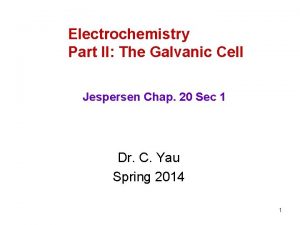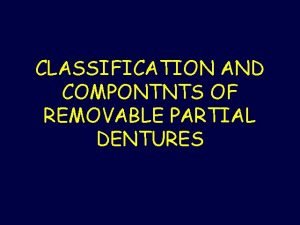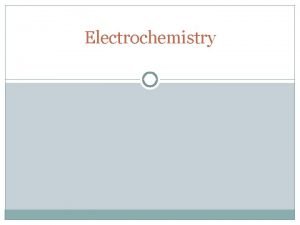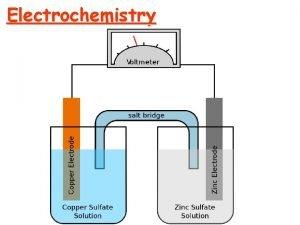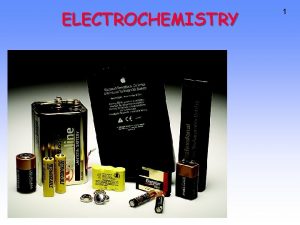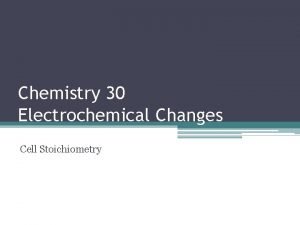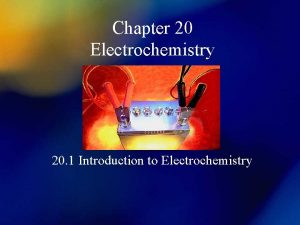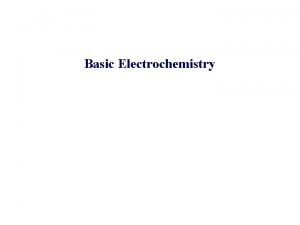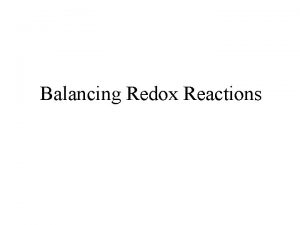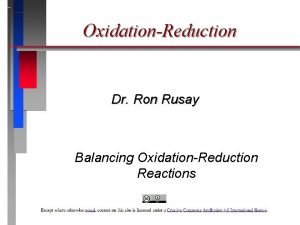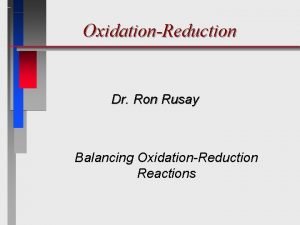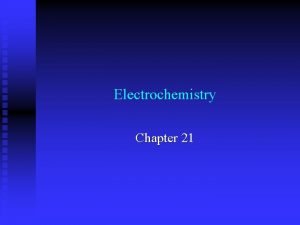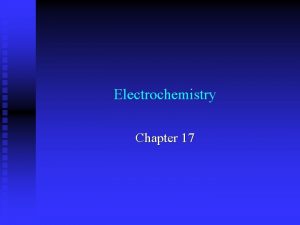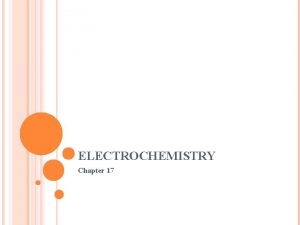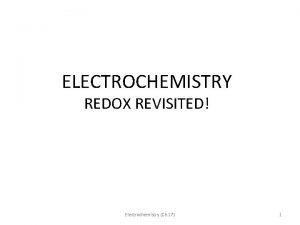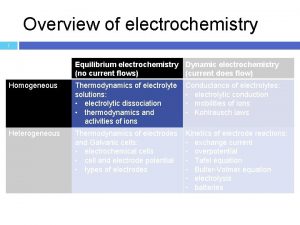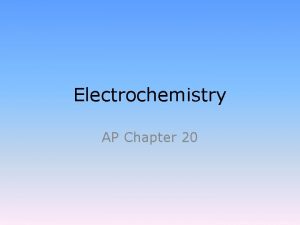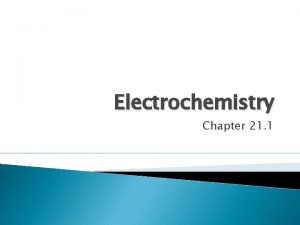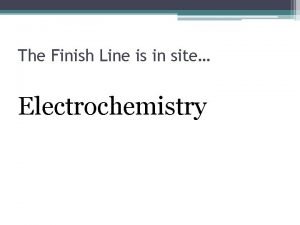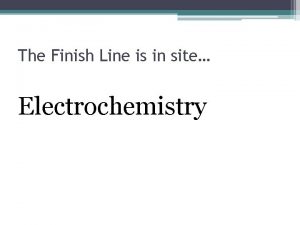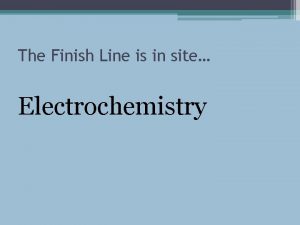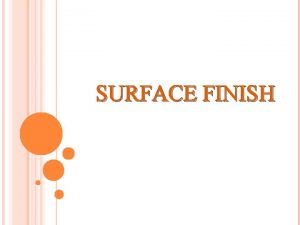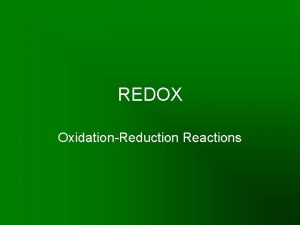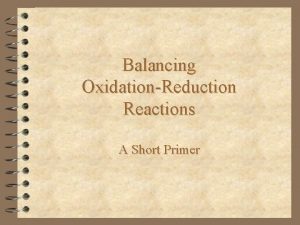The Finish Line is in site Electrochemistry OxidationReduction

















- Slides: 17

The Finish Line is in site… Electrochemistry

“Oxidation-Reduction Reactions” LEO SAYS GER

The Meaning of Oxidation and Reduction (called “redox”) OBJECTIVES Define oxidation and reduction in terms of the loss or gain of oxygen, and the loss or gain of electrons.

OBJECTIVES State the characteristics of a redox reaction and identify the oxidizing agent and reducing agent.

OBJECTIVES Describe what happens to iron when it corrodes.

Oxidation and Reduction (Redox) Early chemists saw “oxidation” reactions only as the combination of a material with oxygen to produce an oxide. • For example, when methane burns in air, it oxidizes and forms oxides of carbon and hydrogen.

Oxidation and Reduction (Redox) But, not all oxidation processes that use oxygen involve burning: q Elemental iron slowly oxidizes to compounds such as iron (III) oxide, commonly called “rust” q Bleaching stains in fabrics q Hydrogen peroxide also releases oxygen when it decomposes

Oxidation and Reduction (Redox) A process called “reduction” is the opposite of oxidation, and originally meant the loss of oxygen from a compound Oxidation and reduction always occur simultaneously The substance gaining oxygen (or losing electrons) is oxidized, while the substance losing oxygen (or gaining electrons) is reduced.

Oxidation and Reduction (Redox) Today, many of these reactions may not even involve oxygen Redox currently says that electrons are transferred between reactants Mg + S→ Mg 2+ + S 2 - (Mg. S) • The magnesium atom (which has zero charge) changes to a magnesium ion by losing 2 electrons, and is oxidized to Mg 2+ • The sulfur atom (which has no charge) is changed to a sulfide ion by gaining 2 electrons, and is reduced to S 2 -

Oxidation and Reduction (Redox) Each sodium atom loses one electron: Each chlorine atom gains one electron:

LEO says GER : Lose Electrons = Oxidation Sodium is oxidized Gain Electrons = Reduction Chlorine is reduced

LEO says GER : q Losing electrons is oxidation, and the substance that loses the electrons is called the reducing agent. q Gaining electrons is reduction, and the substance that gains the electrons is called the oxidizing agent. Mg is the reducing agent Mg is oxidized: loses e-, becomes a Mg 2+ ion Mg(s) + S(s) → Mg. S(s) S is the oxidizing agent S is reduced: gains e- = S 2 - ion

Oxidation and Reduction (Redox) q q It is easy to see the loss and gain of electrons in ionic compounds, but what about covalent compounds? In water, we learned that oxygen is highly electronegative, so: the oxygen gains electrons (is reduced and is the oxidizing agent), and the hydrogen loses electrons (is oxidized and is the reducing agent)

Not All Reactions are Redox Reactions q Reactions in which there has been no change in oxidation number are NOT redox reactions. Examples:

Corrosion q Damage done to metal is costly to prevent and repair q Iron, a common construction metal often used in forming steel alloys, corrodes by being oxidized to ions of iron by oxygen. q This corrosion is even faster in the presence of salts and acids, because these materials make electrically conductive solutions that make electron transfer easy

Corrosion q Luckily, not all metals corrode easily q Gold and platinum are called noble metals because they are resistant to losing their electrons by corrosion q Other metals may lose their electrons easily, but are protected from corrosion by the oxide coating on their surface, such as aluminum q Iron has an oxide coating, but it is not tightly packed, so water and air can penetrate it easily

Corrosion q Serious problems can result if bridges, storage tanks, or hulls of ships corrode q Can be prevented by a coating of oil, paint, plastic, or another metal q If this surface is scratched or worn away, the protection is lost q Other methods of prevention involve the “sacrifice” of one metal to save the second Magnesium, chromium, or even zinc (called galvanized) coatings can be applied
 Kno3 salt bridge
Kno3 salt bridge Hot site cold site warm site disaster recovery
Hot site cold site warm site disaster recovery Finish line rpd
Finish line rpd External finish line in rpd
External finish line in rpd In the race of excellence there is no finish line
In the race of excellence there is no finish line 2110004
2110004 Electrochemistry tutorial
Electrochemistry tutorial While determining the transport number by hittorf's method,
While determining the transport number by hittorf's method, Electrochemistry tutorial
Electrochemistry tutorial Ap chemistry chapter 18 electrochemistry test
Ap chemistry chapter 18 electrochemistry test Oxidation and reduction in galvanic cells
Oxidation and reduction in galvanic cells What is electrochemistry in chemistry
What is electrochemistry in chemistry Electrochemistry balancing equations
Electrochemistry balancing equations Electrochemistry stoichiometry
Electrochemistry stoichiometry Chapter 20 review electrochemistry
Chapter 20 review electrochemistry Electrolysis khan academy
Electrolysis khan academy Aee cd20f
Aee cd20f Balancing redox reactions
Balancing redox reactions
